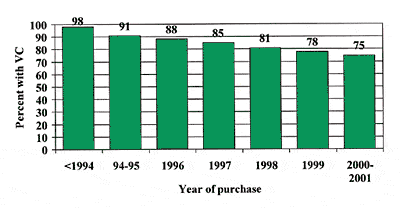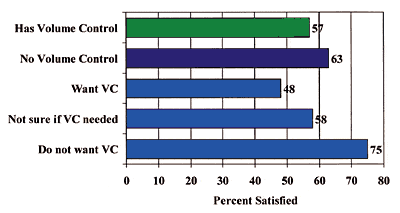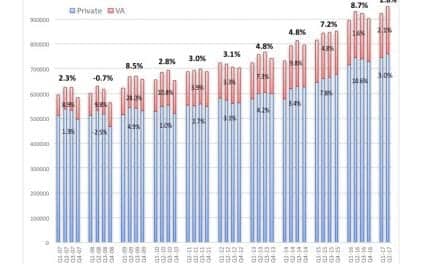The aided threshold allows one to predict the audibility of soft, real-life sounds with the use of nonlinear hearing aids. It is important to recognize that the meaning of the aided threshold has not changed with time or with technology. Rather, it is the generalization of the interpretation that has changed because of the availability of nonlinear aids. In addition, one must guard against using the same interpretation that we used for linear hearing aids when examining the appropriateness of a fitting using this index. Because REM and aided threshold provide different (and important) information, these measures should be used together in the verification of nonlinear hearing aids.
Most hearing care professionals would agree that the application of digital signal processing (DSP) in hearing aids in the last few years has resulted in new and better hearing aid designs and more sophisticated signal processing algorithms (eg, advanced loudness mapping, feedback cancellation, etc). These new algorithms have the potential to improve wearer satisfaction of hearing aids. On the other hand, how one can fairly evaluate these algorithms to reflect their true contribution remains a major challenge for researchers and clinicians alike.
Fueling this difficulty is that many of our current evaluative criteria originate from the “old days” of analog linear, single-channel omni-directional hearing aids. While many of these criteria remain applicable even with the changing technology, some may have become obsolete or at least require a different interpretation. As a profession, it is incumbent upon everyone to raise concern if any of these evaluative criteria may need to be modified to reflect the status of the current technology. Only with public awareness and discussion can hearing care advance with one voice in a prodigious direction.
As a means to stimulate further discussion and perhaps a different way to examine current hearing aid issues, this article will offer a perspective on how technology may have changed our approach to fitting, verifying, and validating today’s nonlinear hearing aids. We will begin with an examination of the meaning and application of the aided threshold (or soundfield measurement).
What is the Aided Threshold?
During threshold determination, the dispensing professional determines the lowest input level on the audiometer dial that the client needs to barely detect the presence of a sound. Therefore, the aided threshold, logically, is the lowest input level that the client hears (ie, the softest sound) while wearing hearing aids set to a specific gain setting. A related term is the functional gain (FG), defined as the improvement in hearing sensitivity (unaided threshold minus aided threshold) consequent to the wear of the hearing aid in the same listening environment. Historically, this term is necessary because the coupler gain on a hearing aid may not reflect the in-situ gain received by the wearer.1
The aided threshold, representing the softest audible sound, includes four important concepts:
1. The aided threshold is a unique perceptual response that requires subjective participation and some level of auditory processing.
2. The aided threshold is an all-or-nothing response; it reflects the softest sounds that the client can hear. There will not be an aided threshold if the stimulus intensity (together with the gain on the hearing aid) fails to exceed the threshold of the wearer—and the aided threshold would not change even though the stimulus intensity increases beyond the threshold level.
3. The aided threshold is tied to the gain setting on the hearing aid. A higher gain setting would lead to a lower aided threshold and vice versa.
4. Lastly, the definition of the aided threshold would imply that this index reflects performance at intensity levels around threshold. As such, this index (and functional gain) should not be used to describe or predict performance at supra-threshold levels.
Aided Thresholds in Linear Hearing Aids
Not the softest sound that can be heard in real-life. Despite the fact that the aided threshold reflects the softest sound that someone can hear with a hearing aid, that interpretation has seldom been explicitly articulated for linear hearing aids. This is because the aided threshold is also tied to the gain setting on the hearing aid, which means that its value can be altered easily through adjustment of the volume control (VC).
For example, the wearer may have a low aided threshold during clinical evaluation in the sound-booth. In real life, the wearer may lower the VC so that loud sounds are comfortable, and raise the VC so that soft sounds are audible. Although the aided thresholds reflect the softest sounds that one hears in the clinic booth, one cannot generalize the interpretation to daily situations. Such an interpretation is only true if no VC adjustment is made on the hearing aid—a situation that is seldom the case for linear hearing aid use.
Gain for conversational speech? Because the gain setting on a linear hearing aid is typically estimated by amplifying conversational speech to the individual wearer’s most comfortable listening level,2 the aided threshold should reflect the results of the gain setting for conversational speech. In other words, the functional gain provided by the linear hearing aid should reflect wearer gain for conversational speech. Indeed, that view has been suggested by Pascoe3 and accepted by many as the meaning of functional gain (or aided threshold).
However, functional gain need not reflect gain for conversational speech. If our profession had used speech produced at a high vocal effort to estimate gain, functional gain would have reflected gain for loud speech instead. On the other hand, because this correspondence also assumes a fixed VC position, the conclusion that functional gain corresponds to gain for conversational speech may only be true inside the test booth and not in real-life situations.
Prediction from insertion gain. With the advent of real-ear measurement (REM) systems in the early 80s, it became clear that the functional gain derived from a linear hearing aid is, on average, similar to the insertion gain (IG) which is defined as the difference between the real-ear unaided response and the real-ear aided response to the same stimulus as measured from the wearer.4

Figure 1 shows the hypothetical in-situ input-output (I-O) curve of a linear hearing aid measured in the wearer’s ear canal at a certain frequency (eg, 1000 Hz). The dotted line represents unity gain where no insertion gain is provided or that the output at the ear canal is the same as the input. Parallel to this diagonal line are lines of increasing gain. For example, the line that is labeled “G=20” relates the output to the input where 20 dB of gain is provided. The output at an input level of 0 dB SPL is 20 dB SPL; or an input of 30 dB SPL leads to an output of 50 dB SPL. If one draws a horizontal line through the y-axis at 50 dB SPL to represent the unaided in-situ threshold of the wearer, then any output exceeding 50 dB SPL (ie, above horizontal line) will be audible to the wearer. In contrast, output lower than 50 dB SPL will be inaudible.
Using this notation, one can see that the aided threshold at a gain setting of G=0 is the same as the unaided threshold, or 50 dB SPL, measured at the eardrum. The aided threshold at the gain setting of 20 dB, which is estimated by noting the input level where the gain curve (G=20) intersects with the in-situ threshold line, is 30 dB SPL. The functional gain is 20 dB.
Next, we examine the real-ear response when the input is adjusted to 60 dB SPL at the eardrum. The real-ear aided output, measured at the same 60 dB SPL input level, will be 80 dB SPL at the gain setting of G=20. Because insertion gain (IG) is the difference between the aided and the unaided SPL at the eardrum, the insertion gain at an input of 60 dB SPL will be 20 dB.
The same insertion gain will be measured at other input levels, as well. For example, 80 dB SPL input leads to an output of 100 dB SPL or an IG of 20 dB. This magnitude of insertion gain—which is equivalent to the magnitude of functional gain—is the same for all input levels (before saturation) at the same gain setting. This observation supports the assertion that the functional gain of a linear hearing aid can be predicted from its insertion gain.
Figure 1 also shows that, as the gain setting is increased (eg, by a VC increase of 5 dB, shown in a dotted-dashed line): 1) the aided threshold will be lowered (eg, by 5 dB to 25 dB SPL); 2) the functional gain is increased (eg, by 5 dB); and 3) the insertion gain at any input level will be increased (in this case, by 5 dB). This illustrates that while insertion gain can predict functional gain for a linear hearing aid, the absolute value of the IG or FG is likely altered by real-life gain setting on the hearing aid. In other words, neither the aided threshold/functional gain nor the insertion gain of a linear hearing aid reflects the real-life gain used by the wearers in all situations.
How Would that be Different for a Nonlinear Hearing Aid?
A nonlinear hearing aid is one that does not have the same gain for all input levels. Typically, more gain (compared to a linear hearing aid) is available for low input level sounds, and gain decreases as input level increases. The degree of compression (ie, compression ratio or CR) varies among nonlinear hearing aids, and/or for different input levels. This type of signal processing method was attempted in the early 60s and has been gradually gaining popularity since the late-80s. Today, surveys indicate that four out of five (79%) hearing aids dispensed in the USA are nonlinear.5

Non-uniform increase in functional gain. The relationship relative to gain discussed above for a linear hearing aid can be substantially different for a nonlinear hearing aid. Figure 2 shows the I-O curve of a simple compression circuit with a compression threshold at 30 dB SPL and a compression ratio of 2:1. Gain at and below 30 dB SPL is set at 20 dB (denoted as G=20). The dotted line shows the unity gain curve. Using the illustration of an in-situ unaided threshold of 60 dB SPL, one can see that the aided threshold will be at 50 dB SPL, or a functional gain of 10 dB will be obtained. If, however, the insertion gain is increased to G=40 dB, the resulting aided threshold will be 20 dB SPL with a functional gain of 40 dB. This means that a gain increase of 20 dB lowers the aided threshold by 30 dB (or increases the functional gain by 30 dB). Unlike the case of a linear hearing aid, changes in functional gain obtained from a nonlinear hearing aid may not correspond to changes in its insertion gain.
Functional gain is not the same as insertion gain. If one presents an input of 60 dB SPL to the wearer measured at the eardrum, the real-ear output measured at the eardrum will be 60 dB SPL at a gain setting of G=0 (or unity gain). If the nonlinear hearing aid is set at G=20 dB, a real-ear output of 65 dB SPL can be measured (Figure 2). This results in an insertion gain of 5 dB. This is different from the 10 dB functional gain reported at the same gain setting. If we now present a 40 dB SPL input, a real-ear output of 55 dB SPL can be measured. This corresponds to an insertion gain of 15 dB, even though the FG remained at 10 dB. In contrast to the special case of the linear hearing aid, where the average functional gain is the same as the average insertion gain at the same gain setting, IG does not always equal FG in a nonlinear hearing aid. Thus, one cannot predict functional gain (or the aided threshold) from insertion gain. The magnitude of the difference depends on the nonlinear characteristics of the hearing aid.
Lower aided threshold in nonlinear hearing aids. The magnitude of the aided threshold may be different from a linear hearing aid as well. To understand that difference, it is necessary to assume that both the linear and the nonlinear hearing aids will amplify conversational speech to the same comfortable listening level. That is, both linear and nonlinear aids should yield the same gain at a conversational input.

Under this assumption, the nonlinear hearing aid will almost always yield more gain than the linear hearing aid for sounds below the conversational level, and less gain for sounds above the conversational level. This is illustrated in Figure 3, which compares the hypothetical I-O curves of a linear hearing aid and a nonlinear hearing aid that has the same gain at a conversational level of 60 dB SPL. If we now draw a 50 dB SPL in-situ threshold line on Figure 3, one can see that the aided threshold of the linear hearing aid is 20 dB SPL, but that of the nonlinear hearing aid is 10 dB SPL. Thus the functional gain for the linear hearing aid will be 30 dB, while the FG for the nonlinear aid will be 40 dB. This suggests that the aided threshold of a nonlinear hearing aid, depending on the CT and how much gain is available for low input sounds, should be lower than that of a linear hearing aid if both hearing aids have the same gain for a conversational input level. A corollary is that the functional gain obtained by a nonlinear hearing aid is necessarily higher than a linear hearing aid that provides the same gain for conversational sounds.
Meaning of functional gain. This being the case, functional gain for a nonlinear hearing aid would not reflect gain for conversational sounds like that for linear hearing aids. Rather, it should reflect gain for soft sounds because the design of the I-O curve is optimized for the perception of low-input sounds. One must not interpret the higher FG obtained from a nonlinear hearing aid to mean more gain from the nonlinear hearing aid (compared to a linear hearing aid) for conversational level sounds. Indeed, this index does not allow one to judge the appropriateness of gain for conversational sounds. The higher gain value reflects the additional gain for soft sounds only.
Meaning of the aided threshold. While the aided threshold still reflects the softest sound audible to a hearing aid wearer (of either linear or nonlinear hearing aids), the generalization of that interpretation differs between a linear hearing aid and a nonlinear hearing aid. In principle, nonlinear hearing aids are designed to automatically change their gain settings as a function of the input levels. This obviates the need for a VC on the hearing aids. Thus, many nonlinear hearing aids (digital and analog) are designed without a VC so the wearers would not be able to adjust the hearing aid gain manually.
The lack of a VC on a nonlinear hearing aid suggests that the clinically determined aided thresholds should reflect the softest sounds that the wearer hears in real life, since the wearer cannot make any manual adjustment. This is an important distinction in the usefulness of the aided threshold between linear and nonlinear hearing aids where the wearer needs to and can adjust the VC on a linear hearing aid in real-life.
Use of the aided threshold in nonlinear hearing aid verification. The fact that the aided threshold on a nonlinear hearing aid (w/o VC) estimates the softest sound that the wearer hears makes it a unique tool for the verification of nonlinear hearing aid performance. A significant benefit is that one can use those indices to estimate the audibility of real-life everyday sounds perceptible by the wearer. For example, if real-life components of soft speech at 1000 Hz occur at 20 dB SPL, and if the wearer’s aided threshold with the nonlinear hearing aid also occurs at 20 dB SPL, one can reasonably conclude that the wearer will be able to detect that speech component in real-life without any manual gain adjustment.
This is a justifiable conclusion because many components of speech and music have restricted bandwidths and are processed similarly as narrow bands of sounds. This is important for counseling and for ensuring that the wearer achieves optimal audibility from the nonlinear hearing aid. Such a tool is more valuable in pediatric fittings where audibility for the softest sounds may be more important than those for adults. With linear hearing aids, one may only estimate the audibility of conversational sounds, and only at the same fixed VC setting that the aided thresholds are estimated.
Should I Use Real-Ear or Aided Threshold for Verification?
Real-ear measure allows an objective evaluation of the output of a hearing aid as measured in the client’s ear canal. In principle, it allows one to measure the processing of a hearing aid (eg, noise reduction, directional microphones, etc), as well as the output of the hearing aid at different input levels (eg, soft and loud sounds). The aided threshold is not meant for this purpose nor is it capable of these applications.
However, these applications of REM should not encourage hearing care professionals to abandon the aided threshold measure and replace it with the exclusive use of REM. This is because the information provided by the aided threshold is neither provided by, nor can it be estimated from, REM with nonlinear hearing aids.
Unlike insertion gain (or real-ear) measurements that do not require a subjective response, the aided threshold is a perceptual response. Because its value is dependent on the subjective response of the user, it cannot be predicted from insertion gain measure. That is, actual measurement is necessary if one is interested in its value.
The fact that the aided threshold does not yield all the applications as REM does not make it an inferior or obsolete verification tool. Instead, it makes aided threshold a unique tool. The usefulness of a verification tool is judged by examining if it provides information on the appropriateness of the fitting and if the same information can be provided more effectively by other means. Because REM and aided threshold provide different (and important) information, these measures should be used together in the verification of nonlinear hearing aids.
REM and aided thresholds (or functional gain) serve a complementary purpose rather than an exclusive purpose. This can be analogous to the complementary use of forks and knives during meals. Forks are meant to pick up food, while knives are meant to cut food. One would not forgo the use of knives because they do not allow one to pick up food. Rather, we would use both utensils in the normal course of a meal. The dining experience may be compromised if one is not used. The same is true for aided threshold and REM; both should be used in the verification of hearing aid performance, but for different purposes. It is more important that we use both now than when the only hearing aids available were linear.


|
Francis K. Kuk, PhD, left, is director of audiology at Widex Hearing Aid Co in Lisle, Ill, and Carl Ludvigsen, MS, is manager of audiological research at Widex A/S in Vaerloese, Denmark. |
Correspondence can be addressed to HR or Francis Kuk, PhD, Widex Hearing Aid Co, 35-53 24th St, Long Island City, NY 11106-4116; email: [email protected].
References
1. Hawkins D, Haskell G. A comparison of functional gain and 2 cm3 coupler gain. J Speech Hear Dis. 1982;47:71-76.
2. Skinner M. Hearing Aid Evaluation. Upper Saddle River, NJ: Prentice Hall;1988.
3. Pascoe D. Frequency responses of hearing aids and their effects on the speech perception of hearing impaired subjects. Ann Oto Rhino & Laryng. 1975;84 (supple 23, 5, part 2):5-20.
4. Hawkins D, Schum D. Relationships among various measures of hearing aid gain. J Speech Hear Dis. 1984;49:94-97.
5. Strom K. The HR 2002 dispenser survey. Hear Review. 2002;9(6):14-32.
6. Mason D, Popelka G. Comparison of hearing aid gain using functional, coupler, and probe-tube measurements. J Speech Hear Res. 1986; 29:218-226.
Correspondence can be addressed to HR or Francis Kuk, PhD, Widex Hearing Aid Co, 35-53 24th St, Long Island City, NY 11106-4116; email: [email protected].





